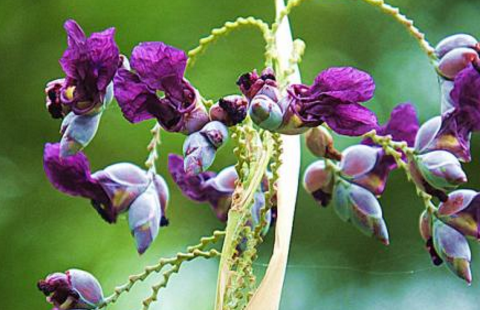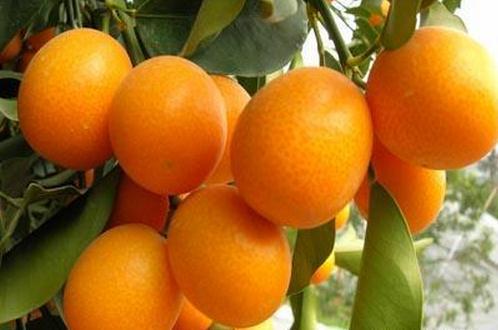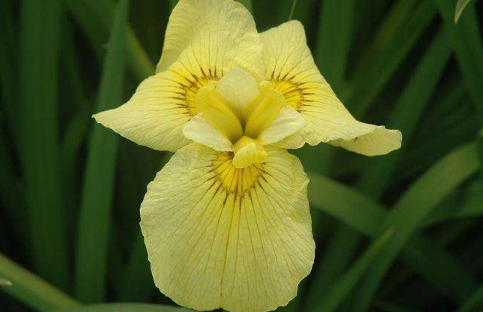Culture method of Rhizoma Rehmanniae
1. Matrix
The substrate for the cultivation of Zailihua can choose the silt of the lake pond or pastoral soil, and it is best to mix some organic fertilizer as the base fertilizer.

two。 Light
Zulihua is a kind of plant that likes sunlight very much, but it is also very shade-tolerant, so avoid light for a week or so, especially in summer, or it will affect the flowering of the plant.
3. Moisture content
Zailihua is an aquatic plant, so it should be planted with less water in spring to promote rooting and sprouting; it should be watered heavily in summer to prevent high temperature damage to the plant, and water should be properly controlled in autumn and winter so that it can survive the winter safely.
4. Fertilizer application
Zulihua culture space is small, nutrients may not be enough for plant growth, in addition to base fertilizer, so fertilizer should be applied twice a month, the concentration should be low, mainly inorganic fertilizer.
Culture method of Rhizoma Rehmanniae
Flower appreciation: pomegranate, Magnolia, Rose, Fusang, June Snow, eight Immortals, Magnolia, Jasmine, Milan, oleander, Hydrangea, Pearl Plum, Gardenia, Nocturne, Hypericum, Arrow Lotus, Gladiolus, Zhu Dinghong, four Seasons Begonia, Bamboo Begonia, Catharanthus roseus, Snake eyes, Calendula, Daisy, Zinnia, Hollyhock, Yu Mei, Fu Lu Kao, Petunia, Big Rock Tree.
Cutting: chrysanthemum, tortoise back bamboo, rubber tree, four seasons begonia, tiger thorn plum, rhododendron, camellia, Magnolia, Milan, sweet-scented osmanthus, Lingxiao, crape myrtle, oleander, gardenia, brocade flower, collateral stone, emerald cypress, June snow. Softwood cuttings are dragon cypress, metasequoia, yellow poplar, ginkgo.
Ramet: Daphne, calla lily, bamboo, fern. Grafting: rose, Camellia, Magnolia, Michelia.
(1) for the grass flowers sown in spring in 2012, May is the seedling stage. The flowers to be transplanted should be moved into the hole plate or seedling cup after 2 true leaves and placed in a well-ventilated place with sufficient sunlight to prevent the occurrence of weak or sudden disease of seedlings caused by excessive density and lack of light. Portulaca oleracea with rapid growth and early flowering stage can be directly moved into the planting pot or application site. Direct seeding flowers that do not need to be transplanted, such as Yu Beauty, Flower Lingcao and time seedlings. Seedlings should be maintained in the shed or balcony to prevent rainstorm and hot sun injury. Weak seedlings to strengthen fertilizer and water management, once a week to apply dilute liquid fertilizer, four seasons begonia seedlings avoid strong light, to shade 50%. To pick the heart to promote branches, such as Catharanthus roseus, a bunch of red, colored leaf grass, marigold, peacock grass, in more than 10 leaves, can be picked 2 times for 3 times. Biennial flowers such as carnation, Yu Mei, Chrysanthemum, kale, osmanthus, violets, primroses, melon and leaf chrysanthemum are collected before the fruits are cracked and stored in a ventilated and dry place.
(2) perennial root flowers
Peony blossoms in May, and the flowering period of each variety is 7-10 days. After peony blossoms in May, the flowering period is 10-15 days, and the total flowering period of early-flowering and late-flowering varieties is 20-30 days. Flowering are Dafuigui, cinnabar verdict, Dahongpao, Danfeng, red hydrangea, Xuefeng, rouge point jade, sand gold crown and so on. Sparse buds in early April, leaving only one flower on top of each stem, and stand a pillar in front of the flower. Like peonies, fertilizers are applied before and after flowering. Peony resistant to drought and afraid of waterlogging, open field cultivation rarely watering, pre-anthesis fertilization such as drought, can be watered, so that the flowers are large and gorgeous.
It was sown from April to May, the night temperature was 15 ℃, germinated in 10 days, and the cuttings took root in 13-16 ℃ in 10 days. Use chicken manure fertilizer or 1% potassium dihydrogen phosphate before flowering and 10% cake fertilizer water after anthesis. The dry golden lotus likes to be wet and avoid waterlogging, and it should be watered frequently with small water, once every 2-3 days in May. After budding, the amount of water can be large, the number of times should be less, the sun should be sufficient, the summer should be properly shaded, and the frame should be erected. There are common Dutch slim, mysterious varieties. Geraniums have tracks, summer rain, tornadoes, lilac afterglow, hot powder, dancing pink, Nano and ice cream, Madong and other varieties. Sowing in early spring could promote branching, and cutting seedlings could take root in 13-18 ℃-10-15 days. The female parent of chrysanthemum was cultivated in May, and the dense, thin and weak branches were cut off to make the fat foot bare. The chrysanthemum was coring or short-cut 3-4 weeks before cutting, so that the sturdy new shoots were used as cuttings.
(3) bulbous flowers
Freesia florescence has passed, the seed balls will be dug up before falling seedlings, ventilated and dry, indoor ventilated storage to be sown in autumn. The flowering period of Ranunculus Ranunculus has passed, so the seeds should be collected in time. The mother plant should be placed in a semi-cool place to prevent the leaves from withering early, which is conducive to the development of the underground part. Gladiolus is suitable for planting balls. Zhu Dinghong is planted in the open field and blossoms in May. The dry bulb is planted in May and blossoms in July. Change the pot and ramet in time after the gentleman orchid. The suitable sowing time is from April to May, and it can germinate quickly at 18-25 ℃. It can be sowed in the pot and transplant after emergence. Lily musk lily blossoms in May. Dutch lily can promote flowering by fertilization in May, and early flowering varieties can also bloom.
(4) foliage plants in May is a good season for foliage plants to grow. Move outdoors as early as possible and apply quick-acting fertilizer based on nitrogen fertilizer every 10 days. Generally, shading is 30% 50% May-August is a good season for cutting. Ivy, Phyllostachys pubescens, Guangdong evergreen and creeping duckweed are easy to take root in water, change water once a month, take root in 10 days, and transplant before aging. Brown bamboo, Guanyin bamboo, cycad can be sown, root begonia, tiger tail orchid can be inserted in leaves, plantain and dragon blood trees can be inserted in stems, reticulated grass, taro, purple goose down and cold water flowers can be inserted in leaf buds.
May is the season for changing pots for foliage plants. The substrates include 40% peat for palms, 30% garden soil, 30% river sand; pineapples: 40% rotten leaf soil, 30% tree shavings and coconut bran, 30% river sand; ferns: rotten leaf soil 50%, peat 25%, river sand 25%; begonia: rotten leaf soil 40%, garden soil 30%, river sand 30%, asparagus and hanging orchid: garden soil 50%, rotten leaf soil 25%, river sand 25%.
(5) Cactus and succulent plants in May is the season for the growth and reproduction of cacti. Grafting dosage Tianzhu (suitable for strong thorn ball and polygonal ball), wood unicorn, cactus, Wolong column as rootstock. It will take place on a sunny day at 20: 25 ℃. Cut horizontally on the rootstock, then cut 20-45 degrees along the edge, cross-cut the lower part of the scion with a thickness of more than 4 in diameter, immediately place it on the rootstock, align the vascular bundles of the rootstock, and bind the thin thread longitudinally. Cleavage is used for fairy finger and crab claw orchid, 15cm cross-cut above the basin, cut a wedge-shaped incision on the top or side, cut the scion into the shape of a duck's bill, insert it into the rootstock, fix it with needles, thorns and wooden clips, place it in a shady place, keep it warm for 25 ℃ and cover it.
Using river sand, vermiculite and perlite as substrate, 20-24 ℃ is easy to root, winter dormancy type is from mid-April to early June, summer dormancy type is better from late September to early October. Leaf, stem or root cuttings are available. The cuttings are 5 cm long and 10 cm long, and then inserted after drying. If the wound has white juice, it should be coated with sulfur powder and inserted into the soil.
Cactus has two ecotypes, one is epiphytic on the stony wall of tree trunk, the stem is flat and leaf-shaped or slender columnar, born in tropical rain forest, such as epiphyllum, lotus, crab claw orchid, cactus finger, rat tail, measuring ruler, etc., like planted in humus-rich, loose, well-drained wet substrate, like semi-shade, high air humidity, avoid direct sunlight, shade in summer, spray more water, and apply liquid fertilizer containing potassium every 15 days. The other is native to desert and gravel, spherical or flat, propagates with seed balls, and should be planted in sand, gravel and other substrates with low nutrients and good drainage, preferring light. Except for 30% shading in hot summer, it can be direct sunlight, extremely resistant to drought, and should be kept moist in the growing season; only by applying low concentration fertilizer once a month can it grow luxuriantly and the seeds are larger. Many cacti begin to blossom in May. Pulpy plants need plenty of sunlight and moist substrate in May and apply liquid fertilizer every semimonthly to promote the growth of branches and leaves.
(6) Woody flowers the rhododendron season ends in May. If it is not well managed, it is easy to die. Attention should be paid to management after flowering. Rose blossoms in spring from April to May, and fertilization should be applied before flowering for the first time. Rose is extremely fond of light, good light, black spot light, we should pay attention to the prevention and control of black spot, powdery mildew and aphids. With 75% chlorothalonil 1000 times and 70% methyl topiramate used alternately, the disease prevention effect is particularly good. Jasmine entered the new shoot growth period in May, so it is necessary to strengthen fertilizer and water management, so watering should be diligent and avoid stagnant water.
White orchids blossom in May. Keep the soil moist without stagnant water. The leaves of Magnolia are big and the stem is thick. They like to be fat and avoid thick fat. Hydrangea can be cut with leaves (2-3 pairs of leaves) in May. Hydrangea likes to be wet, it can not be short of water during the growing period, and its leaves wilt and recover quickly after watering, but affect the differentiation of flower buds. Hydrangea likes nitrogen fertilizer. From April onwards, the fertilizer of N: P: K is 2: 2: K is 2 / 4 times, and less fertilizer is applied after May, so as not to affect flower bud differentiation. From May to September, shading 20% 50%, the prosperous period with 1000 mg / L paclobutrazol foliar spray, can make it dwarf.
Bergamot, Xiangyuan, Daidai and lemon are easy to drop flowers and fruits in May. To prevent fruit drop, you can pick the heart of the tender shoots and spray 40 mg / L naphthalene acetic acid, anti-falling hormone or 100 mg / L gibberellin for 3 times. For trees and branches that are too prosperous, they can be cut or peeled around the base of the trunk or branches, with a width of 0.2cm to 0.5cm.
Potted cultivation method of Zili Flower planting density
Then the flower language and florescence have been shared with you, and there must be some partners who can't wait to breed. Next, Xiaoqi will share with you the cultivation method of potted flowers and the planting density of flowers.
First, the cultivation method of Zili flower pot.
1, container selection: re-force flower pot containers should generally choose aquatic plant planting containers with a height and inner diameter greater than 20 cm, such as cylinders, bowls, pots, bags, etc., sometimes for the needs of plant landscaping, when choosing a container, you also need to consider the texture and appearance of the container and other factors.
2, planting substrate: the substrate for planting can choose the silt of the lake and pond, or you can directly choose the pastoral soil, especially the pastoral topsoil, such as raw soil, it is best to mix a certain amount of organic fertilizer as base fertilizer when planting.
3. Planting method: when planting Lihua, first put the planting substrate in the container which occupies the height of the container, and then add water to the position where the height of the container is 2pm, then you can combine the ramet for planting. When planting, the vegetative propagation is generally planted in the center of the container, with a depth of about 5 cm.
4. Light management: Zailihua is a light-loving plant, but it can also tolerate shade. About a week after ramet transplanting, especially those planted with leaves should be properly shaded, especially in summer, because the water layer of the planting container is shallow, the strong light will make the water temperature rise quickly, which is very disadvantageous to the growth of plants. even affect survival.
5. Water layer management: the water layer of Zulihua is planted in containers, mainly in shallow water in spring, in order to increase the temperature of the substrate and promote rooting and sprouting, while in summer, it is mainly in deep water to prevent plants from being damaged by high water temperature. Proper water control in autumn and winter to facilitate safe winter.
6. Nutrient management: due to the limited nutritional conditions of the substrate of the planting container, the frequency of topdressing is obviously more than that of open field production except base fertilizer. "frequent application of thin fertilizer" is its basic principle. The type and concentration of fertilizer should be determined according to the different growth periods of plants, generally mainly inorganic fertilizer, and appropriate topdressing of organic fertilizer.
Second, the planting density of Zili flower
The planting density of Zili garden is generally larger, and the plant row spacing can be controlled at 1 m × 1 m. The density of ornamental cultivation should be smaller to facilitate rapid landscape formation, and the plant-row spacing can be controlled at about 0.6 meters × 0.6 meters. Because the underground stem of Zili flower is stout, the diameter of the underground stem of one-year-old plant can reach 3-4 cm, so the planting depth can reach 10 cm.
The above is the method of potted cultivation of Zili flowers and the sharing of planting density. If there are conditions, you can plant on the ground and plant a piece of Zili flowers. When the flowers bloom, it is definitely a scenic line.
- Prev

Conservation methods and matters needing attention of kumquat
1. Kumquat likes sunshine and warm and humid environment, so it is best to put kumquat in a sunny place, but pay attention to moderate light in summer, so that kumquat will grow well. 2. Pruning is a very important thing for kumquat. Pruning must be done according to the requirements.
- Next

Culture methods of Acorus calamus
1. Acorus calamus likes loose and breathable sandy soil, which can be mixed with vermiculite, river sand and nutritious soil, and the loam rich in humus is the best. two。 Water calamus likes a humid environment, daily watering to keep the soil moist, but also to keep the environment moist, can spray water to the leaves and around to prevent drought
Related
- Fuxing push coffee new agricultural production and marketing class: lack of small-scale processing plants
- Jujube rice field leisure farm deep ploughing Yilan for five years to create a space for organic food and play
- Nongyu Farm-A trial of organic papaya for brave women with advanced technology
- Four points for attention in the prevention and control of diseases and insect pests of edible fungi
- How to add nutrient solution to Edible Fungi
- Is there any good way to control edible fungus mites?
- Open Inoculation Technology of Edible Fungi
- Is there any clever way to use fertilizer for edible fungus in winter?
- What agents are used to kill the pathogens of edible fungi in the mushroom shed?
- Rapid drying of Edible Fungi

